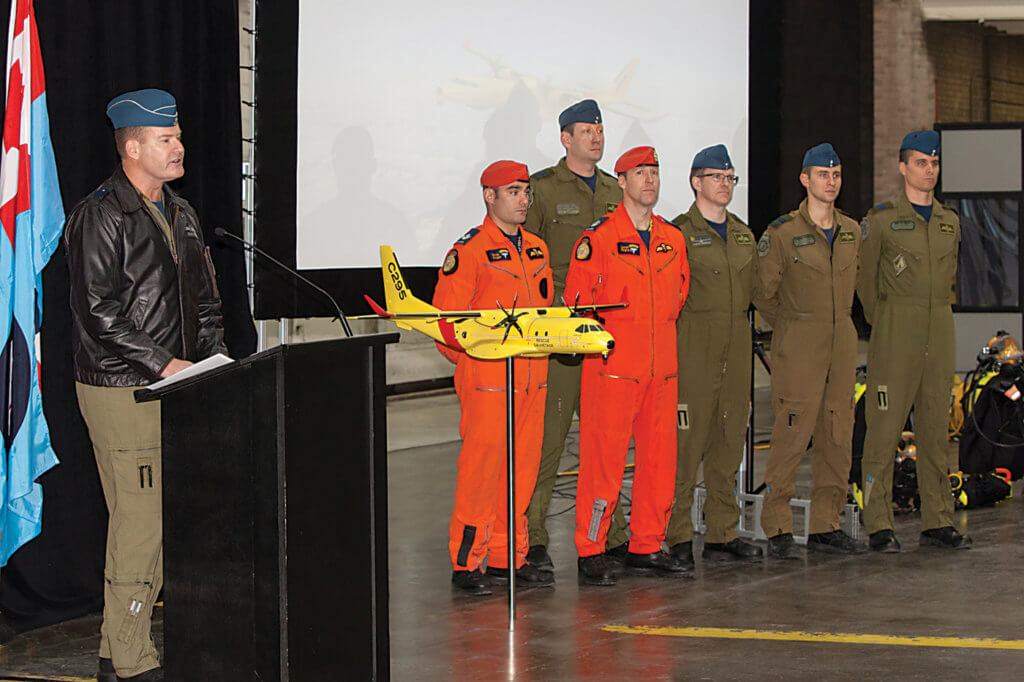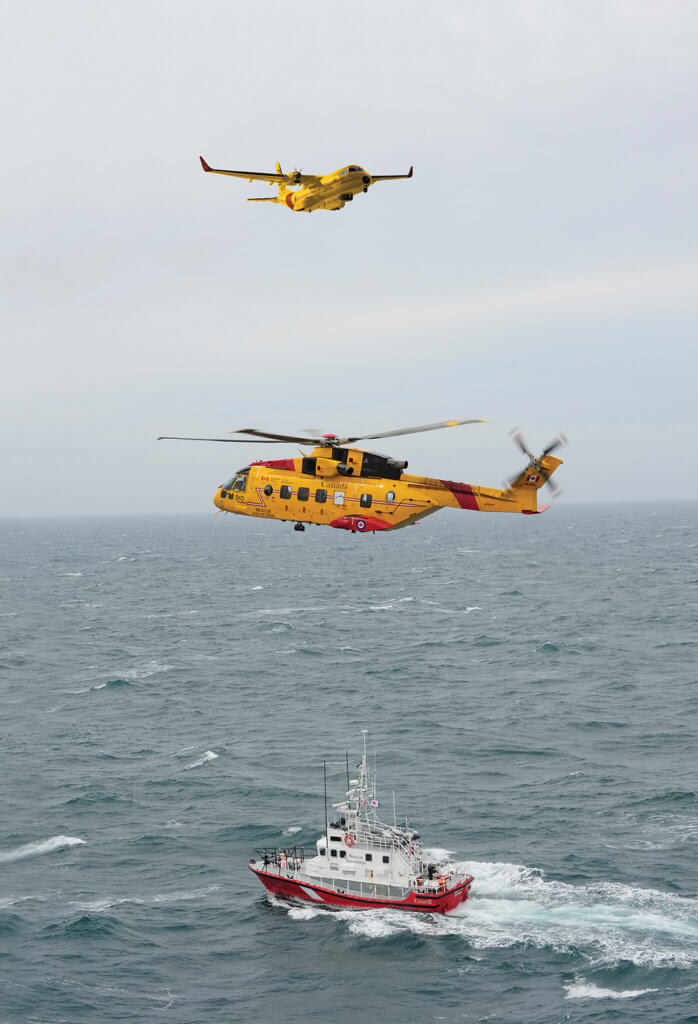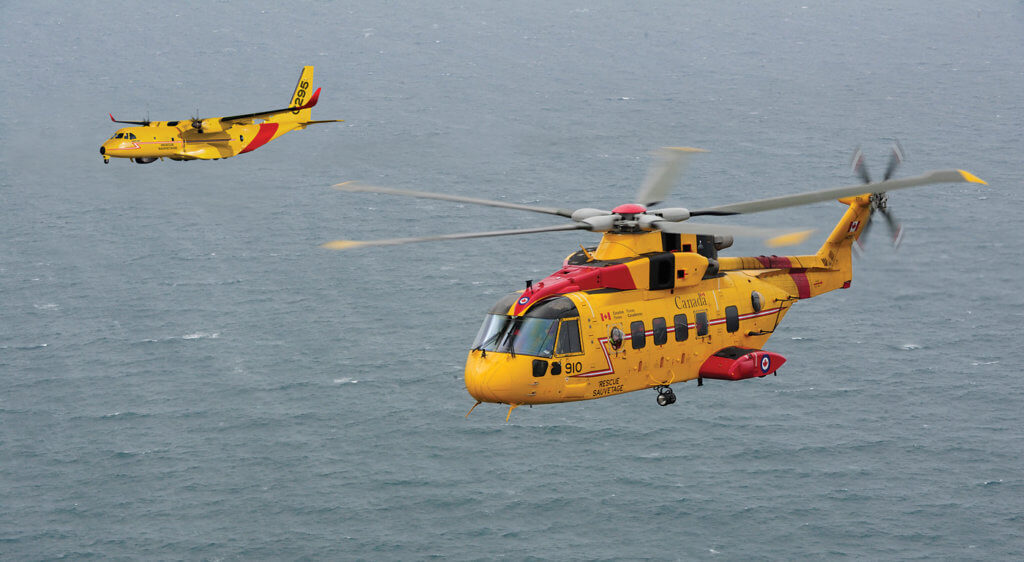Estimated reading time 12 minutes, 26 seconds.
Forgive Fernando Alonso for looking a little shell-shocked on Dec. 8, 2016. Just 48 hours earlier, the head of military aircraft for Airbus Defence and Space had been informed at his office in Spain that the company’s C295W had won Canada’s fixed-wing search and rescue (FWSAR) competition.

Standing in the hangar of 424 Transport and Rescue Squadron at 8 Wing Trenton, Ont., on that cool winter morning amidst government ministers, senior officials, search and rescue technicians and other military personnel, reality began to set in.
“Until this morning, I was saying it’s not really true,” said Alonso. “Now I am starting to believe it is true.”
Though an early December announcement about the FWSAR competition had been expected for several months, the winner remained a closely guarded secret up until two days before the formal press conference. Air force public affairs officers and executives with Airbus admitted it was a scramble to coordinate an event.
“I only found out yesterday that Airbus won this competition,” acknowledged LGen Mike Hood, commander of the Royal Canadian Air Force (RCAF), while standing in the hangar at Trenton.
“People don’t believe how good [the government] was at keeping it quiet,” said Simon Jacques, head of Airbus Defence and Space in Canada.
The announcement of a dedicated search and rescue aircraft to replace the RCAF’s fleet of CC-115 Buffalos and the CC-130H Hercules assigned to SAR duty concluded a procurement competition that has sputtered hot and cold over the past 14 years, since it was first declared a government priority in 2003.
The $2.4 billion contract will be rolled out in two phases. The first includes delivery of 16 aircraft, beginning in 2019 and concluding by 2022, as well as construction of a new training centre in Comox, B.C. The second will cover five years of maintenance and support.

The agreement includes options to provide maintenance and support services for an additional 15 years, bringing the total value to $4.7 billion.
The advanced capabilities of the C295W, in particular its integrated radar and sensor suite and communications and data management systems, represent a new paradigm for search and rescue, according to Hood.
RCAF FWSAR crews respond to over 350 missions each year across an 18 million square-kilometre area of responsibility (AOR) that extends from the Pacific Ocean to the North Pole and well out into the eastern Atlantic. The increased endurance of the C295W, as well as its ability to identify and track up to 200 search objects simultaneously, in low light and poor weather conditions, and share that data in real time with other military and civilian partners in the air, on the ground or at sea, “will fundamentally change the SAR paradigm for us,” said Hood. “I believe search and rescue is going to become a lot less about search and a lot more about rescue.”
“This aircraft is a game-changer for search and rescue in Canada,” said Defence Minister Harjit Sajjan. “It represents a great technological improvement of our [SAR] capabilities for the future.”
Alonso, who earlier in his career conducted cold weather testing of various Airbus planes in Iqaluit, N.W.T., said the C295W was well prepared for Canada’s harsh winter climate. “Your country is very kind to offer the most horrible operation conditions that people can experience,” he said.
In a twist on the usual bidding process, companies were asked to suggest basing solutions to most effectively cover the AOR. Airbus’ proposal maintained the air force’s current operating bases in Greenwood, N.S.; Trenton; Winnipeg, Man.; and Comox. The exact distribution of the new aircraft, however, would be “defined more accurately in the days to come,” said Hood.

The C295W features two Pratt & Whitney Canada PW127G turboprop engines, an Airbus integrated tactical system, and an L-3 Wescam advanced electro-optical/infrared turret system. CAE will construct and deliver the simulator-equipped training centre while PAL Aerospace, under a joint venture with Airbus called AirPro, will provide the in-service support.
Other partners to date include Heroux-Devtek for landing gear repair, Hope Aero for propeller repair, Precision Aero for repair of various other components, and Sonovision for technical publications.
Under the government’s Industrial and Technological Benefits policy, Airbus will be expected to make investments in Canadian companies equal to the value of the contract. Since C295W assembly and systems integration are already performed in Spain, most of that will come in the form of indirect benefits as Airbus seeks more Canadian content for its global supply chain.
Pablo Molina, head of Airbus Military Aircraft Canada, said Airbus is still seeking some components for the C295W, but emphasized in its bid that the plane was fully assembled and certified as a means to minimize risk. Jacques added that the aircraft already contains about 20 per cent Canadian components.
Airbus has now sold over 170 C295 aircraft to almost 25 customers, including as a dedicated SAR platform to Portugal, with a large Atlantic Ocean area of responsibility, and Finland, with Arctic search requirements. An earlier variant, the CN235, is operated by the U.S. Coast Guard as HC-144A Ocean Sentry for maritime patrol, transport, ISR and disaster relief.
“End-to-end solution”
The FWSAR project has suffered a tortured history. Though both Liberal and Conservative governments deemed it a priority, a request for proposals (RFP) to replace the six remaining CC-115 Buffalos, which first entered service in 1967 as tactical transport aircraft, was repeatedly delayed. The statement of requirements (SOR) was changed multiple times and on several occasions media leaks suggested the government was considering a sole-source deal for the Alenia C-27J Spartan.
In 2009, the National Research Council of Canada (NRC) was asked to review the SOR. Its final report, released in March 2010, concluded that the requirements were “over-constrained” and limited the number of potential bidders.

By that point, however, a half dozen potential bidders were offering suggestions for the FWSAR project, including Bombardier and its Dash-8, Viking Air with a new build of the DHC-5NG Buffalo, Lockheed Martin and the C-130J Hercules, and Bell-Boeing with the V-22 Osprey.
In the wake of the NRC report, the government also weighed the merits of a two-fleet solution and considered “alternative service delivery” models that would have allowed industry to assume more of the SAR role.
When the 200-page RFP was finally released in March 2015, the field had slimmed to three: Airbus, Leonardo (Alenia), and Embraer Defence, a late entrant with its KC-390 that is still under development in Brazil.
Among the evaluation measures, each aircraft was assessed against more than 7,000 SAR incidents to which the RCAF has responded in the past five years, using a computer model to measure response time to reach the search area, time on station and recovery time.
The RFP also took a different approach. Rather than seek a like-for-like replacement of the aircraft, Public Services and Procurement invited industry to submit proposals for “detailing an end-to-end solution,” including basing requirements, number and type of aircraft, and training and maintenance program, what Minister Judy Foote called a “complete search and rescue service.”
“If you ask industry, this was the first time they have ever been so engaged,” she told Skies, noting that Canadian companies have expertise that can help solve these sorts of challenges, including the longer-term in-service support (ISS) that often exceeds the initial acquisition costs.
“Our overall objective is to establish a long-term collaborative relationship with industry to sustain our equipment and fleets,” Foote told an aerospace industry audience in November. “[We want] to find ways to encourage contractors to be more efficient and innovative and build flexibility into contracts to adapt to changing needs over time.”
“This is a change in how procurements have been done all across the world,” said Molina. “Now you will see more capability-based requirements instead of very technical and directed requirements. A combination of best products, services and partners is what makes capability…and having the best partners in the country has helped us.”

The announcement was a blow for Leonardo, which had been considered by many as the leading contender almost since the FWSAR project was first launched in 2003. The C-27J Spartan has greater speed and endurance, and could better “put first responders on station” to do their work, retired LGen Steve Lucas, a spokesperson for Team Spartan, told Skies at a briefing in November.
The team, which included General Dynamics Mission Systems-Canada, DRS Technologies, KF Aerospace, and IMP Aerospace, planned to assemble the C-27J, including its flight management and mission systems, at IMP’s facilities in Halifax, N.S. Leonardo and General Dynamics were proposing a joint venture called Spartan Aviation Services to serve as the ISS integrator.
At the time of contract announcement, Team Spartan said it had no comment on the decision pending a government debrief.
Foote said both the C295W and C-27J were deemed compliant. After a fair and transparent competition, “it came down to the cost,” she said, which was worth 25 of 100 points in the evaluation process.
Winning the long-running FWSAR competition is undoubtedly a coup for Airbus. But it might be just the first Canadian footprint for the C295W. Earlier this year, the manufacturer toured the North with a Mexican Air Force plane to highlight its endurance, cargo capacity and self-sufficiency to commercial airline operators looking to replace aging fleets with more robust alternatives. Airbus will be hoping one success story feeds the other.
Chris Thatcher is an aerospace, defence and technology writer and a regular contributor to Skies.

One Less Platform Please.
I would have liked the RCAF to receive more C-130-Js
The Hercs are more capable and could be containerized for multiple-role operations.
what a shame.
C-130 costs so much compared to C-295 w.Canada made a great decision by choosing best airplabe in its category…Bravo Airbus!
Would have been nice to buy Canadian and support the success story that is Viking Air .